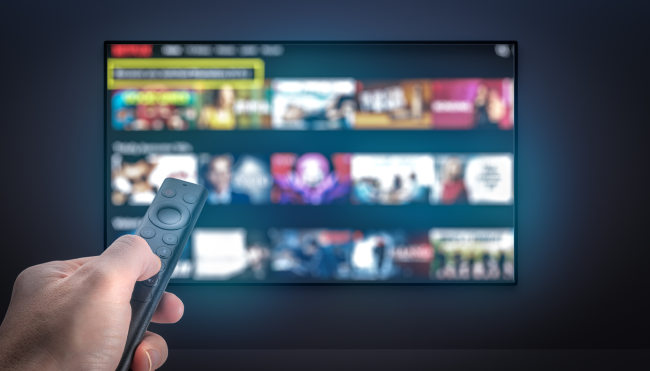- Why Amagi
-
Solutions
Contact UsBusinessWho We Serve
- Offerings
- AI
-
Resources
Contact UsINDUSTRY REPORTSAmagi FAST Report #15: The Power of Live Programming: A Catalyst for Streaming SuccessAugust 21, 2025Read More
-
Company
Contact UsNewsroomAmagi launches AI-powered Smart Scheduler to improve content programmingApril 3, 2025Read More
Blog
4 Major Challenges of VOD Distribution & How to Solve Them
By Vijay P Sankar, Senior Manager, Product Marketing, Amagi - April 5, 2022
Companies that began by producing web content - like Tastemade, which creates cooking, design, and travel videos - are coming to see video on demand services as a profitable tool for expanding their reach and revenue streams.
But your foray into VOD will only be as lucrative as your VOD distribution strategy. Many content owners come to us because of the amount of work and challenges involved in the process, including:
- Having to tailor their content to the different formatting and delivery specifications of each VOD platform (and updating that content when the platforms change their spec requirements).
- Managing a large library of content across multiple VOD platforms and having to log in to each platform's separate content portals to do so.
- Having to work with multiple vendors for different aspects of the VOD distribution process (e.g, one vendor for content delivery, one for ad monetization, etc.).
We created this guide to help content creators/studios better understand the ins and outs of VOD distribution so they know what to expect going in. We'll discuss the four major challenges you'll face and how Amagi's suite of tools makes them easier to handle.
We cover:
- Placing your content on profitable VOD platforms
- Complying with the technical specs of VOD platforms
- Managing your content & VOD platforms
- Monetizing your VOD content
Amagi is a cloud broadcasting platform that enables you to host, deliver, manage, and monetize your content all in one unified location. If you want to make distributing your VOD content easier and more profitable, contact us now.
1. Placement: How to get on profitable VOD platforms

The placement process - i.e. getting your content onto VOD streaming platforms - can be more difficult than you may think, as there are hundreds of platforms to choose from (and growing).
You'll need to evaluate each platform based on metrics (like the number of users, user demographics, user location, content aggregation, etc.) and monetization models (more on this in the Monetizing Your Digital Distribution Strategy section) to see if they'd be a good fit for your video content.
If you rush onto a platform with a small base of users who aren't interested in your content, then your content won't perform well, and you won't make enough money. And managing even a small number of platforms/content requires a large investment of time and resources.
But the platforms you choose will also have to choose you: They'll determine if your content will add value to their platform and whether or not to pursue a licensing agreement with you.
While Amagi doesn't make distribution agreements for you (it's up to you to secure licensing agreements with the VOD platforms you want to deliver to), working with a cloud playout service like Amagi provides two major advantages with regard to placement:
A.Amagi has an extensive and growing list of platform partners that we can deliver content to, like Hulu, Redbox, and more.
Our digital distribution network extends beyond the US and into Latin America, Europe, and Asia.
Some VOD platforms we're connected with include:
- Fubo TV
- Simplestream
- Apple TV+
- Hulu
- YouTube TV
- PLEX
- FreeCast
- And more…
Distribute VOD assets to leading platforms.
Amagi delivers VOD content to 25+ SVOD and AVOD platforms, and is continuously expanding its distribution network in the US and other countries across Latin America, Europe and Asia.

Because of these relationships, we have insight into the user base and content of our platform partners. We can help you identify which platforms would make a good fit for your content and put you in contact with them (though you'll have to secure a streaming agreement with them on your own).
And we also make specific recommendations to our platform partners about content/content creators that we think would serve their platform well.
Bottom Line: Working with Amagi makes it easier to find, connect with, and deliver your content to the right VOD platforms (and makes it easier for them to find you).
B.Amagi is a preferred partner for many platforms.
Many VODs are particular about how content gets delivered onto their platforms. They only work with trusted content delivery vendors in order to maintain content quality and operational efficiency. It's less complicated for them to work with a few select vendors than it is to work with multiple different vendors who have different tech. The more vendors they work with, the more opportunities for error.
Most VODs have a list of "preferred partners" you'll need to use in order to get your content onto their platform. For example, Amagi is a preferred partner for platforms like LG and Vizio.
As a preferred partner, we know how these VODs want content formatted and delivered to their platform. Which brings us to the second major VOD distribution challenge…
2. Complying with the technical specs of VOD platforms

snippet from the Hulu Content Partner Guidebook.
Every VOD streaming service has different technical specifications for how your content must be formatted and delivered to its system.
For example, some use the HLS streaming protocol to transport video files, while others use MPEG-DASH. Some require s3-based file transfer, while others use IBM Aspera.
Each platform also has different requirements for how content metadata must be delivered. While one platform will require each piece of content to be labeled with a title and short description, another platform will want a title, description, and genre label. Others will want even more information. And character limits might be different for each one.
Complicating matters further, spec and metadata requirements can change quarterly (or even more frequently) on any given platform.
If you have an in-house team of engineers, you may be able to manage spec compliance for a moderate amount of content on one to two different VOD platforms.
But as your content library grows and you extend beyond five platforms, things quickly become unmanageable. You'll be forced to either grow your in-house management team (which will be costly) or use a service like Amagi Cloudport.
Amagi ON-DEMAND offers a plug-and-play solution to this issue. You simply need to ingest your content and metadata into our system once. Then, Amagi automatically tailors it to the formatting, encoding, and delivery specs of each VOD platform you deliver to. In other words, Amagi will automatically know exactly which parts of your metadata to use, how to format the video, how to deliver the video, and so on.
You can also import your metadata into our system in your preferred format — mRSS, Excel spreadsheet, etc. Amagi will keep track of any changes to your VOD platforms' spec/metadata requirements and automatically adjust your content to meet them.
Amagi handles all of the technical aspects of VOD distribution so you don't have to hire a team to manage them.
3. Managing your content & VOD platforms

Managing your VOD content is the most labor-intensive aspect of VOD distribution.
As we've said, each platform has different spec requirements, and those requirements change periodically.
If you have 1,000 pieces of content on six different VOD services, you'll need to keep track of the six different sets of specs and adjust all 1,000 pieces of content every time a change occurs.
And each of these platforms will have a different content portal - i.e. a web-based platform where you upload your content into their system. (Here is Hulu's portal, for example.) Every time you need to make changes to your content, you'll have to log in to each portal separately.
This is where Amagi's plug-and-play solution becomes incredibly valuable. You only need to ingest your content into Amagi Cloudport once. Then you can manage everything in one unified location.
Once your content and metadata are in our system, you can deliver them to your VOD platforms and manage all content, channels, and platforms using our tool. So when you want to add or remove content from any VOD, for example, you can do so from your Amagi dashboard - which saves time, money, and manpower.
Amagi can also handle playout for linear TV delivery on FAST platforms (like Roku). And with our simple drag-and-drop playlist scheduler, you can create and deliver program schedules for all your linear channels from the same interface.

So, if you're already delivering content linearly and want to expand to VOD (or vice versa), you can deliver and manage your content for both types of OTT platforms via Amagi.
4. Monetizing your VOD content
There are four types of VOD business models:
|
Four Video-on-Demand Business Models |
|
|
SVOD Platforms: Subscription Video On Demand Consumers can access your content when they join a VOD subscription service that aggregates many content offerings in one place. Examples: Netflix, Max, Hulu, Disney+, Sundance Now. |
AVOD Platforms: Ad-Based Video On Demand Consumers can access your content for free with intermittent ad breaks. Examples: Hulu (free version), Crackle, Vudu, TiVo+, Tubi. |
|
TVOD Platforms: Transactional Video On Demand The digital equivalent of Blockbuster, where consumers can access your content on a pay-per-view basis (aka electronic sell-through). Examples: Amazon Prime Video, iTunes, Apple TV, Google Play, Vimeo. |
vMVPD Platforms: Virtual Multichannel Video Programming Distributors Platforms that provide both VOD and linear television content. Examples: YouTube TV, Xfinity, Peacock, Pluto TV, Sling TV. |
Monetizing your content on a transactional VOD or subscription VOD is pretty straightforward. With TVODs, you get paid every time someone buys or rents your content. And with SVODs, the platform pays you a flat fee upfront to secure the rights to your content.
But if you choose to put your content on an ad-supported platform, like an AVOD or a vMVPD, then you'll need technology to prep your content for ads, insert the ads, and provide insights into ad performance.
Some VOD platforms handle ad insertion on their end (known as client-side ad insertion) and just send ad revenue back to the creator. But this method presents two issues:
- Lack of Ad Analytics: VOD platforms provide you with little to no insight into how the ads on your streaming videos are performing, which content is generating the most ad revenue, and so forth. Without this data, you can't make decisions about how you plan and distribute content in order to maximize revenue (more on this below).
- Susceptible to Ad-Blockers: CSAI ads are easier for ad-blockers to block. If viewers don't see the ads, they won't buy the promoted products. While you'll still get credited for impressions from blocked ads, it can hamper your revenue earning potential. When the ads on your content generate more conversions, you can charge advertisers more and earn more money - which won't happen if the ads are being blocked.
For those reasons, SSAI (server-side ad insertion) — i.e. when content creators stitch ad triggers directly into their content stream — is superior.
When SSAI tools deliver an ad, they use viewer data taken from the VOD platform (e.g., info about the viewer's demographics, location, search history, etc.) to select and display the most relevant ads to each viewer. This helps advertisers reach their target audience more effectively, leads to better ad performance, and enables content creators to generate more revenue from the ads on their content.
To do SSAI, you'll need to use an SSAI tool. That means introducing another vendor to your VOD management operation, which brings more complexity and more time spent coordinating different vendors and tasks.
But with Amagi's suite of tools, you get access to Amagi THUNDERSTORM: a dynamic SSAI tool that can handle all aspects of ad insertion and content packaging.
Amagi THUNDERSTORM solves both problems presented by CSAI:
- Real-Time Ad Analytics: Amagi THUNDERSTORM gives you real-time access to ad analytics, like impressions, users, sessions, geolocation, ad network performance, which content is generating the most ad revenue, etc. You can use this insight to tailor your ad strategy to maximize revenue. For example, if you notice that ads on your cooking shows perform particularly well, you can create more cooking shows and generate more ad revenue.
- Unblocked Ads: Because ad-blockers aren't sophisticated enough to adequately detect SSAI ads, your ads won't get blocked, and your ad revenue won't be hindered.

And while Amagi THUNDERSTORM enables you to manually insert ad triggers like other SSAIs, it also utilizes artificial intelligence to automatically detect ad opportunities and display ads at the best time.
Bottom Line: With Amagi, you can manage/optimize content delivery and ad monetization all in one unified location.
Make VOD distribution easier & more profitable with Amagi
You can use Amagi to host, deliver, manage, and monetize your VOD and linear content all from one unified location.
It resolves the four major challenges of VOD distribution and, in doing so, significantly reduces the complexity, cost, and manpower involved.
It's important to note that Amagi is not the same thing as a content distributor. We don't promote your content to audiences like film distribution agencies do for indie films. While we can introduce you to VOD platforms, it's up to you to secure licensing agreements with them yourself. Small filmmakers are often best-served by seeking relationships directly with SVOD and TVOD platforms or by cutting a deal with a distributor.
But, if you have TV shows, podcasts, a large collection of independent films, news footage, sports footage, or any other large video content pool, working with Amagi to get on as many platforms as possible makes good business sense.
By handling all the technical aspects of VOD distribution, Amagi gives you more time to promote your content, secure profitable licensing agreements, and do what you do best: Create amazing content! If you want to make distributing your VOD content easier and more profitable, contact us now.
Related Blogs
Get started
Increase revenue and reach with our Broadcast & Streaming solutions.
Cloud modernization. Streaming unification. Monetization. Marketplace.
 German
German French
French Spanish
Spanish Korean
Korean Japanese
Japanese Portuguese
Portuguese


